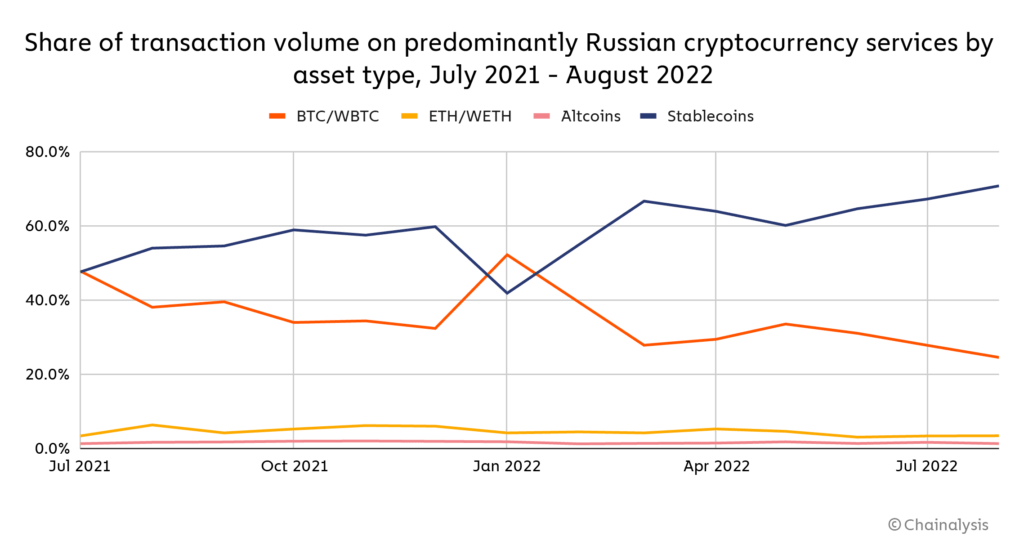Russian stablecoin usage surged after Ukraine invasion: Report

A new report from blockchain analytics firm Chainalysis has shown a surge in stablecoin usage in Russia following the Russian invasion of Ukraine, which has since seen sanctions and inflation impacting the country.
Released on Oct. 12, the report revealed that the share of stablecoin’s transaction volume on primarily Russian services increased from 42% in January to 67% in March following the invasion, and has continued to increase since.
An anonymous expert on regional money laundering speaking to Chainalysis suggested that Russia’s removal from the cross-border system SWIFT is likely to see crypto being utilized for cross-border transactions, with stablecoins likely to be the preferred medium of exchange due to their price stability.

Share of transaction volume on predominantly Russian crypto services by asset type, from July 2021 to August 2022. Source: Chainalysis.
The report also suggests that some of the surge in stablecoin usage is likely due to ordinary Russian citizens trading the Ruble for stablecoins in order to protect the value of their assets, amid high levels of inflation since the war began.
“While some of that may be due to businesses embracing cryptocurrency for international transactions, it’s also likely that some of the increase is due to ordinary Russian citizens trading for stablecoins in order to protect their assets’ value, as we discussed previously,” the report noted.
Related: Dapper Labs suspends Russian accounts after new EU sanctions
Meanwhile, Chainalysis also noted in its finding that Eastern Europe had the highest share of risky crypto activity compared to any other region worldwide over the last year.
18.2% of cryptocurrency activity in the region is either “risky” or “illicit,” with Eastern Asia the next highest at 15% and Sub-Saharan Africa coming in third, though the latter had by far the largest share of illicit activity involving cryptocurrency.
The firm defined risky activity as any transaction that involves an address associated with a risky entity, such as exchanges with low or no Know-Your-Customer (KYC) requirements. Meanwhile, illicit activity is defined as transactions associated with a known criminal entity.

Share of risky and illicit crypto activity for different regions from July 2021 to June 2022. Source: Chainalysis.
Recent developments relating to crypto could further increase this number. The European Union recently banned crypto payments from Russians to European wallet providers, which could drive more cryptocurrency users to use lesser-known exchanges with no KYC requirements in order to get around the sanctions.
The report noted that crypto being used to work around sanctions means there needs to be more discussion on improving the effectiveness of sanctions but also highlighted the positive role crypto has had in facilitating donations to the Ukrainian cause, placing the current figure at over $65 million.
In prior research, Chainalysis noted that Russian cybercriminals was driving significant ransomware and cryptocurrency-based money laundering activity, noting:
“In particular, we’ve historically seen an outsized amount of ransomware and crypto-based money laundering in Eastern Europe, with the latter supported by a large ecosystem of risky cryptocurrency businesses.”






 Bitcoin
Bitcoin  Ethereum
Ethereum  Tether
Tether  USDC
USDC  TRON
TRON  Dogecoin
Dogecoin  Cardano
Cardano  Bitcoin Cash
Bitcoin Cash  Chainlink
Chainlink  LEO Token
LEO Token  Stellar
Stellar  Monero
Monero  Litecoin
Litecoin  Zcash
Zcash  Hedera
Hedera  Dai
Dai  Cronos
Cronos  Tether Gold
Tether Gold  OKB
OKB  Ethereum Classic
Ethereum Classic  KuCoin
KuCoin  Gate
Gate  Algorand
Algorand  VeChain
VeChain  Cosmos Hub
Cosmos Hub  Dash
Dash  Stacks
Stacks  Tezos
Tezos  TrueUSD
TrueUSD  IOTA
IOTA  Basic Attention
Basic Attention  Decred
Decred  Theta Network
Theta Network  NEO
NEO  Synthetix
Synthetix  Qtum
Qtum  Ravencoin
Ravencoin  0x Protocol
0x Protocol  DigiByte
DigiByte  Nano
Nano  Zilliqa
Zilliqa  Siacoin
Siacoin  Numeraire
Numeraire  Waves
Waves  Ontology
Ontology  Status
Status  Enjin Coin
Enjin Coin  Pax Dollar
Pax Dollar  BUSD
BUSD  Lisk
Lisk  Hive
Hive  Steem
Steem  Huobi
Huobi  NEM
NEM  OMG Network
OMG Network  Augur
Augur  Bitcoin Gold
Bitcoin Gold  Ren
Ren  HUSD
HUSD